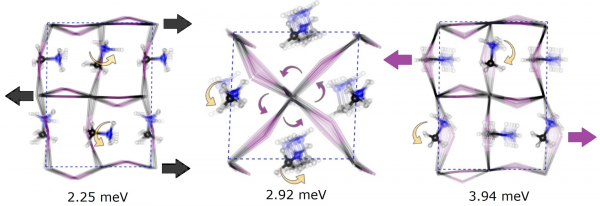Unraveling the Ordered Phase of the Quintessential Hybrid Perovskite ─ Thermophysics to the Rescue
Hybrid (organic-inorganic) perovskites were discovered in the 1970s. Until quite recently, they were widely regarded as mere academic curiosities because of their rather exotic ‘ionic-plastic-crystal’ character. Today, they have become one of the most promising platforms for the development and subsequent deployment of next-generation photovoltaic and photonic technologies.
Notwitstanding the above, taming the stability of hybrid perovskites remains an unresolved challenge, deeply rooted in the complexity of their physico-chemical behaviour. The ongoing ´hybrid-perovskite fever´ in materials research is, therefore, in dire need of a robust microscopic picture of their multitude of phases, as well as of the nature and extent of the underlying disorder. In this work, we have addressed this ongoing challenge for the case of the ordered phase of methylammonium lead iodide (MAPbI3), the most-celebrated hybrid perovskite. To this end, we have combined state-of-the-art neutron-scattering techniques, computational materials modelling and thermophysical data into a single and unified framework. At low temperatures, we find that the specific heat of MAPbI3 exhibits strong and systematic deviations from the Debye limit, a common feature in pure hybrid perovskites and their mixtures. Our analysis and interpretation of the experimental data using first-principles calculations shows that the local structure around the organic cation is characterized by a substantial lowering of the local symmetry relative to what is inferred from crystallographic (time-averaged) studies. Furthermore, the physical origin of the observed thermophysical anomalies can be explained quantitatively in terms of the presence of sub-Terahertz optical photons, associated with translational-librational distortions of the octahedral (inorganic) units. In the particular case of MAPbI3, our results also make it evident that widely accepted structural models lead to overly strong interactions between the organic and inorganic sublattices. These new insights have been possible by undertaking a detailed assessment of the performance of last-generation density functionals, via a direct comparison of their predictions with experimental data. The former have reached a sufficient level of maturity such that plausible structural models can now be scrutinized in unprecedented detail. Methodologically, we have made use of a hitherto unexploited experimental observable for quantitative model selection – the heat capacity. To the best of our knowledge, this is the first time that such a protocol has been implemented with success in hybrid perovskites, and anticipate that its realm of applicability can be extended to other classes of materials where other experimental probes fall quite short at providing physical insight.

Representative low-energy modes responsible for the thermophysical anomalies observed in MAPbI3.



